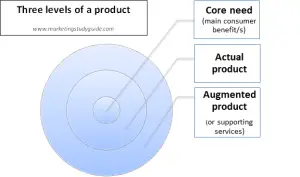One helpful way of thinking about a product as a marketer is to split the product into levels. By analyzing the product at different levels, a marketer can have a better understanding of the product’s competition, how the design meets the needs of the market, and how it can be supported and clearly differentiated in the marketplace.
This product level model is presented in quite a few marketing textbooks, with the product models showing three, four or five product levels. The most common model in introductory marketing textbooks shows the product as having three levels or components – more advanced marketing textbooks are more likely to discuss the model with five product levels.
Contents
 The three product levels in marketing
The three product levels in marketing
Let’s start by listing what the three product levels are:
- The core need or benefit
- The actual product
- The augmented product (sometimes referred to as supporting or associated services)
Usually the product level model is presented in a circular fashion, as shown in the diagram, with the core need or benefits to consumers positioned at the center of the model as shown:
The core need or benefit
The first level (at the center of the model) is the core need or benefit that the product is trying to meet or deliver. The best way to think about this is from a consumer’s perspective – why is the customer buying this product solution?
You should note the use of the word “solution” at the end of the last paragraph and you should be aware that products to consumers are simply solutions to problems or needs that they are facing.
Let’s use some simple examples: why does a consumer purchase breakfast cereal? Because they are hungry (have a need) in the morning. Why does a consumer buy a magazine? Because they find them entertaining or it prevents boredom or fills time (various benefits delivered to the consumer).
Actual product
The actual product is the second product level and is quite simple to understand. The actual product is that the overall product design and the product features. If you were to describe a product in detail, then you would be describing its product features – which is the actual product.
As an example, let’s consider breakfast cereals again. When describing the cereal you would identify the following product features: shape, taste, texture, size, color, aroma, crunchiness, smoothness, ingredients, packaging, name, brand, images, and so on.
Obviously there would be 1000s of ways to design a breakfast cereal, but this would be the actual product design (set of product features) for a particular breakfast cereal offering. A key goal of the marketer is to ensure that the product design needs the core need (or required set of benefits) for the consumer. This means that there should be a relationship between the first product level (core need) and the second product level (a set of product features designed to meet that core need).
Augmented product (or supporting services or other attributes)
In everyday language, augment means “to add to” or “to make greater” – it is a word often associated with music. Therefore, the third level in the product level model is increasing the offering and set of benefits to the consumer. But we have already designed the product’s features (as part of level two), so product augmentation is adding to the product’s offering OUTSIDE of the product itself.
A good way to look at product augmentation is by using an example. Again we will go back to our breakfast cereal example. We could support (add extra value and benefits through product augmentation) the overall product offering of breakfast cereals by:
- Providing a free replacement of the cereal (if it unsatisfactory)
- Having recipe ideas on the packaging
- Having a QR code on the packaging (with a link to a site or offer)
- Having a code to access free online games
- Having a discount coupon for a future purchase
- Having interesting information on the packaging
- Donating a percentage of the sale to a charity
What you should note in each of these examples of product augment that the actual product (the cereal itself) is NOT modified – the changes occur with the existing packaging, websites, sponsorships, and so on.
You should also note is that the augmented product features provide some additional benefits to consumers. These benefits should help to differentiate the product in the marketplace and win a greater share of the market.
RELATED TOPICS
